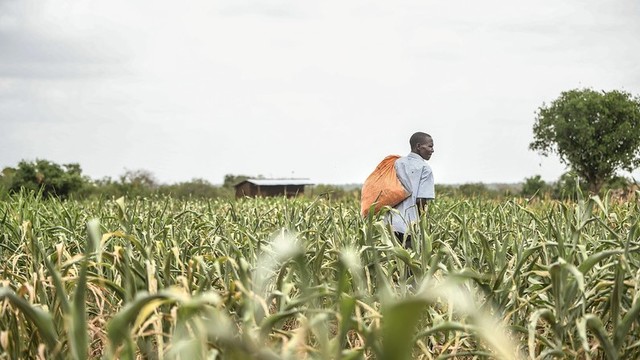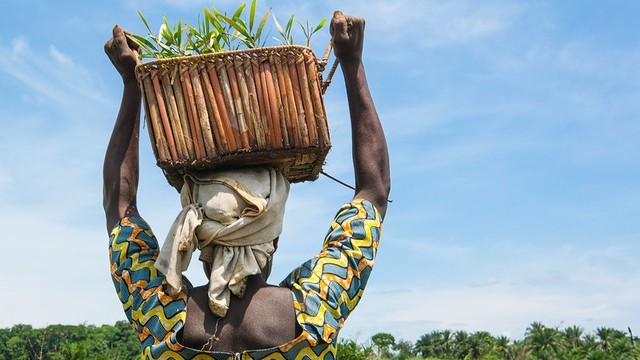Valuing a traditional lifestyle: how Maasai herders are being paid to protect nature and combat climate change
Guest blogger Jo Anderson shares how a community-run conservation area becomes financially sustainable thanks to carbon revenues.


A Maasai herder from the Makame community walks his cattle (Photo: copyright Carbon Tanzania/Roshni Lodhia)
The Maasai Steppe can be a harsh and unpredictable place to live for the Maasai herders who inhabit its savannah woodlands and open plains. In some years, rainfall is restricted to a few months. When rain does fall, it is typically brought by storms that are patchy and variable in length.
The dry season is frequently longer and more severe than those still alive today can remember – an indication that climate change is exacerbating this unpredictability.
Yet the pastoralist culture that has evolved in this most iconic of East African landscapes allows the Maasai to navigate and respond to this unpredictability.
Managing local land
There are few better examples of this ability to access seasonally variable grazing areas across a landscape at different times of the year than among the communities of the Makame Wildlife Management Area (WMA), a locally-led community-based organisation formed in 2012 by members of five villages in northern Tanzania’s Kiteto district.
Here, the Maasai herders concentrate around permanent water sources during dry periods of the year, and then spread out to access seasonally abundant grazing and water across the greater landscape during the rainy season, areas that also harbour an impressive variety of wildlife and biodiversity.
In a world where land-hunger is driving farmers to seek ever greater areas to plough and plant, some parts of the rangelands appear unused for periods of the year, opening the window for unplanned and unlawful farming in areas with low potential for agricultural productivity.
The WMA structure enables these communities to gain tenure over their rangelands through a land planning process that restricts agricultural expansion and secures the important woodlands and grasslands that allow the Maasai to continue to practice their traditional semi-nomadic lifestyle, where economic value is seen through a lens of livestock ownership, and which is a powerful example of how Indigenous Peoples and local communities (IPLC) are often the most effective stewards of global biodiversity.
Carbon credits: generating income, protecting nature
The challenge for these communities is to fund the protection activities, governance processes and administrative tasks needed to maintain this resource tenure, while also providing and supporting the development needs of the village communities.
Sustainable trophy hunting can be a source of income for local communities and while permitted in the Makame WMA, it has not provided adequate income for the WMA to become financially self-sustainable.
In 2016, with capacity and financial support from key partners the Ujumaa Resource Community Team (URCT) and The Nature Conservancy, the Makame WMA worked with Carbon Tanzania to design and develop a forest-based carbon project which would be funded through the generation and sales of carbon credits.
– Edward Lekaita MP, former WMA board member and UCRT lawyerThe concept of being paid for protecting traditional woodlands and grazing areas was completely alien to the Maasai, but as a representative of UCRT who was born and raised in Makame, I was able to introduce the idea to my community and build trust that it was a real opportunity to benefit from strengthening our traditional land use practices
The Makame Savannah REDD project provides sustainable finance for the management of Tanzania’s largest community managed protected area, and is a leading example of locally-led conservation supporting the goals of the global biodiversity framework to be agreed later this year at the CBD COP15.
For us at Carbon Tanzania, the structure of the Makame WMA, a legally constituted community-based organisation, has enabled us to develop a project that creates value out of the traditional land use practices of the Maasai people, practices that are by nature designed to manage and protect seasonally dispersed and variable natural resources and their constituent biodiversity.
Fundamental to our approach is that given the right incentives, namely strong and reliable land tenure, and equitable financial compensation for the conservation services they provide, IPLCs are the best stewards of their own natural resources.
As such we treat the Makame WMA as a contributor to the global community. And with the COP27 climate conference taking place in Egypt in November likely to forefront the role of IPLCs in mitigating climate change, and the subsequent COP15 biodiversity conference sending out a similar message, this example is critical to demonstrate to the global community that there are impactful, accountable and equitable pathways to invest in nature.
Through their annual efforts to protect 350,000 hectares of woodlands, the Maasai herders receive payment in proportion to the amount of carbon that is locked up in these wildlife-rich ecosystems. The measurement and annual monitoring of the carbon value of these areas is a practical (and currently the only) way for these communities to access financial markets, thanks to the burgeoning demand for carbon credits in the global voluntary carbon market.
The protection of important biodiversity makes the carbon credits even more valuable to buyers in this market.
While the sale of carbon credits provides finance for the Makame WMA to train and pay rangers, support them in the field and cover the cost of law enforcement activities, it also supports socio-economic development in the wider communities – in December 2021 the community received one billion shillings (US$500,000) in carbon revenues during the first three years of operation.
Autonomy and transparency
Since the Makame WMA does not receive donations – instead earning revenues from the generation and sales of carbon credits – they are not answerable to donors and can autonomously decide how funds are spent.
WMAs follow a transparent, consultative process with their participant villages, followed by a similar accountability process so all community members know where money has been allocated and spent.
The Makame WMA has benefited from support of technical partners, notably the Honeyguide Foundation that specialises in supporting community led organisations to strategise, plan and manage their natural resources and resulting revenues.
– Damian Bell, HoneyguideFoundationThanks in large part to carbon revenues, the Makame WMA is now fully sustainable from a financial point of view, something that has proved elusive for the majority of Tanzania’s WMAs.
This goes a long way to ensuring equitable relationships between the WMA and its investors and helps them realise true value from their natural resource management efforts.
This locally-led conservation work, funded through the voluntary carbon market, demonstrates that when communities are treated equitably as partners in addressing climate change and biodiversity loss, long-term sustainable solutions are within reach.
We see these models of locally-led approaches as fundamental to delivering the goals of the Paris climate agreement and targets of the global biodiversity framework. Local cultures, and their associated needs and priorities, are at the heart of these processes.



